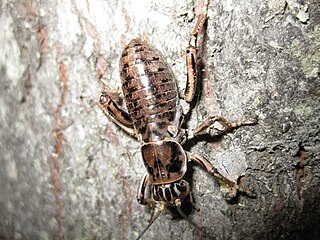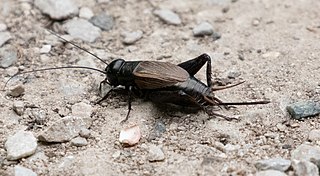
Insects in the family Tettigoniidae are commonly called katydids or bush crickets. They have previously been known as "long-horned grasshoppers". More than 8,000 species are known. Part of the suborder Ensifera, the Tettigoniidae are the only extant (living) family in the superfamily Tettigonioidea.

Orthoptera is an order of insects that comprises the grasshoppers, locusts, and crickets, including closely related insects, such as the bush crickets or katydids and wētā. The order is subdivided into two suborders: Caelifera – grasshoppers, locusts, and close relatives; and Ensifera – crickets and close relatives.
Stridulation is the act of producing sound by rubbing together certain body parts. This behavior is mostly associated with insects, but other animals are known to do this as well, such as a number of species of fish, snakes and spiders. The mechanism is typically that of one structure with a well-defined lip, ridge, or nodules being moved across a finely-ridged surface or vice versa, and vibrating as it does so, like the dragging of a phonograph needle across a vinyl record. Sometimes it is the structure bearing the file which resonates to produce the sound, but in other cases it is the structure bearing the scraper, with both variants possible in related groups. Common onomatopoeic words for the sounds produced by stridulation include chirp and chirrup.

Hump-winged grigs are insects belonging to the genus Cyphoderris, in the family Prophalangopsidae, and superfamily Grylloidea (crickets). In modern times they are known only in northwestern North America and central Asia, but the fossil record indicates a wider distribution in the past.

The family Prophalangopsidae are insects belonging to the order Orthoptera. They are the only extant members of the superfamily Hagloidea. There is only one extant genus in North America, where they are known as grigs, four genera in Asia, and many extinct genera.

Ensifera is a suborder of insects that includes the various types of crickets and their allies including: true crickets, camel crickets, bush crickets or katydids, grigs, weta and Cooloola monsters. This and the suborder Caelifera make up the order Orthoptera. Ensifera is believed to be a more ancient group than Caelifera, with its origins in the Carboniferous period, the split having occurred at the end of the Permian period. Unlike the Caelifera, the Ensifera contain numerous members that are partially carnivorous, feeding on other insects, as well as plants.

A tegmen designates the modified leathery front wing on an insect particularly in the orders Dermaptera (earwigs), Orthoptera, Mantodea, Phasmatodea and Blattodea (cockroaches).

Tree crickets are insects of the order Orthoptera. These crickets are in the subfamily Oecanthinae of the family Gryllidae.

Deinacrida fallai or the Poor Knights giant wētā is a species of insect in the family Anostostomatidae. It is endemic to the Poor Knights Islands off northern New Zealand. D. fallai are commonly called giant wētā due to their large size. They are one of the largest insects in the world, with a body length measuring up to 73 mm. Their size is an example of island gigantism. They are classified as vulnerable by the IUCN due to their restricted distribution.
Gryllotalpa major,also known as the prairie mole cricket, is endemic to the United States and is the largest cricket in North America. Its natural habitat is temperate grassland and it belongs to the family Gryllotalpidae. It is threatened by habitat loss, and is currently only found in Oklahoma, Kansas, Missouri, Nebraska and Arkansas. Males of this species produce sounds by rubbing their fore wings together. They sing from special burrows they construct in the prairie soil to attract females for mating, and they can be heard at distances up to 400 m from the burrow. Males aggregate their acoustic burrows in a lek arena and are very sensitive to vibrations carried through the ground. Males communicate with neighboring males through vibrational signals, and the songs they project to flying females are harmonic chirps, rather than the trills produced by most mole crickets.

Gryllus pennsylvanicus is known as the fall field cricket. G. pennsylvanicus is common in southern Ontario, is widespread across much of North America and can be found even into parts of northern Mexico. It tends to be absent in most of the southwestern United States including southern California. Within its geographic range this field cricket will burrow into soil in fields and forest edges. Individuals inhabit grassy disturbed areas and are often found around areas of human habitation.

Gryllus veletis, commonly known as the spring field cricket, is abundant throughout eastern North America. G. veletis is a solitary, aggressive, omnivorous, burrow-inhabiting species of cricket. This species is commonly confused with Gryllus pennsylvanicus, as they inhabit the same geographical area. However, the two species are easily distinguished through examination of life history, ovipositor and behavioural differences. Predators of G. veletis include American toads, wild turkeys, red-tailed hawks, wolf spiders and red-backed salamanders.

Crickets are orthopteran insects which are related to bush crickets, and, more distantly, to grasshoppers. In older literature, such as Imms, "crickets" were placed at the family level, but contemporary authorities including Otte now place them in the superfamily Grylloidea. The word has been used in combination to describe more distantly related taxa in the suborder Ensifera, such as king crickets and mole crickets.
Panoploscelis is a genus of very large insects belonging to the true katydid tribe Eucocconotini, which is a subfamily of the Tettigoniidae. Like the other members of the suborder Ensifera, Panoploscelis are part of the insect order Orthoptera, which also contains crickets, grasshoppers and locusts. Members of this genus are among the largest katydids of the Neotropics.
Gryllus integer, commonly known as the western trilling cricket, is one of many species of field cricket in the genus Gryllus. It is called the "triller" field cricket because its song is nearly continuous rather than broken into discrete chirps. G. integer can be found in parts of the Western United States, having been recorded from Oregon, California, Arizona and New Mexico.

Grylloidea is the superfamily of insects, in the order Orthoptera, known as crickets. It includes the "true crickets", scaly crickets, wood crickets and other families, some only known from fossils.

Cyphoderris strepitans, the sagebrush cricket or sagebrush grig, is a one of only a few surviving species in the family Prophalangopsidae. Three of these species are in the genus Cyphoderris and all three are endemic to North America. C. strepitans name is from the Latin word 'strepitans' which means 'making a great noise', refers to their calling song during the mating season.

Chlorobalius is a genus in the bush cricket or katydid family containing a single species, Chlorobalius leucoviridis, commonly known as the spotted predatory katydid. C. leucoviridis is a predator and is an acoustic aggressive mimic of cicadas; by imitating the sounds and movements made by female cicadas, it lures male cicadas to within its reach and then eats them.

Caedicia simplex is a species of bush cricket or katydid, native to New Zealand and Australia. A common name is the "common garden katydid".

Wētā is the common name for a group of about 100 insect species in the families Anostostomatidae and Rhaphidophoridae endemic to New Zealand. They are giant flightless crickets, and some are among the heaviest insects in the world. Generally nocturnal, most small species are carnivores and scavengers while the larger species are herbivorous. Although some endemic birds likely prey on them, wētā are disproportionately preyed upon by introduced mammals, and some species are now critically endangered.
















